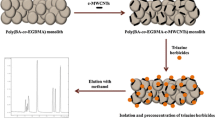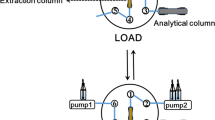Abstract
In this work, a porous polyvinylpyrrolidone/single-walled carbon nanotube incorporated polymerized high internal phase emulsion (PVP/SWCNT-polyHIPE) monolithic column was fabricated and developed as a solid phase extraction (SPE) adsorbent coupled with high performance liquid chromatography-fluorescence detection (SPE-HPLC-FLD) for the determination of tetracycline (TC), oxytetracycline (OTC), chlorotetracycline (CTC), and doxycycline (DC) in environmental water samples. The proposed monolithic sorbent was easily produced by in-situ polymerizing of high internal phase emulsions (HIPEs), and performed high extraction ability to the four tetracycline antibiotics (TCs). The extraction conditions including sample pH, sample flow rate, sample volume, desorption solvent and its volume were studied by investigating the recoveries of the four TCs, and the optimal extraction conditions were obtained. Under the optimized conditions, the PVP/SWCNT-polyHIPE based SPE-HPLC-FLD method exhibited good linearity in the range of 20–800 ng/mL for four tetracycline antibiotics with correlation coefficients higher than 0.9996. For water samples, the detection limits (LODs, S/N = 3) ranged from 1.0–2.5 ng mL−1 for four tetracycline antibiotics. The intra-day (n = 15) and inter-day (n = 5) precisions (expressed in terms of relative standard deviation (RSD %) were in the range of 0.5–2.2 and 1.3–5.7%, respectively. The spiked recoveries were in the range of 85.0–101.7 % with RSDs lower than 4.0%. Furthermore, the prepared polyHIPE monoliths allowed more than 100 extraction cycles without any loss in the extraction efficiency. The developed method enables us to detect trace tetracycline antibiotics in water samples. The method can be useful in the extraction and determination of antibiotics in all kinds of environmental water samples.



Similar content being viewed by others
REFERENCES
Silverstein, M.S., PolyHIPEs: Recent advances in emulsion templated porous polymers, Prog. Polym. Sci., 2014, vol. 39, pp. 199–234.
Zhang, T., Sanguramath, R.A., Israel, S., and Silverstein, M.S. Emulsion templating: Porous polymers and beyond, Macromolecules, 2019, vol. 52, pp. 5445–5479.
Sun, G., Li, Z., and Ngai, T., Inversion of particle stabilized emulsions to form high internal phase emulsions, Angew. Chem., Int. Ed., 2010, vol. 49, pp. 2163–2166.
Zhu, W., Zhu, Y., Zhou, C., and Zhan, S., Pickering emulsion templated polymers: Insights into the relationship between surfactant and interconnecting pores, RSC Adv., 2019, vol. 9, pp. 18909–18916.
Pulko, I., Smrekar, V., Podgornik, A., and Krajnc, P., Emulsion templated open porous membranes for protein purification, J. Chromatogr. A, 2011, vol. 1218, pp. 2396–2401.
Sun, Y., Li, Y., Xu, J., Huang, L., Qiu, T., and Zhong, S., Interconnectivity of macroporous molecularly imprinted polymers fabricated by hydroxyapatite stabilized Pickering high internal phase emulsions hydrogels for the selective recognition of protein, Colloid Surf., B, 2017, vol. 155, pp. 142–149.
Huš, S., Kolar, M., and Krajnc, P., Separation of heavy metals from water by functionalized glycidyl methacrylate poly (high internal phase emulsions), J. Chromatogr. A, 2016, vol. 1437, pp. 168–175.
Zhu, Y., Wang, W., Yu, H., and Wang, A., Preparation of porous adsorbent via Pickering emulsion template for water treatment: A review, J. Environ. Sci., 2020, vol. 88, pp. 217–236.
Zhang, S.M., Wang, D.J., Pan, Q.H., Gui, Q.Y., Liao, S.L., and Wang, Y.P., Light triggered CO2 breathing foam via nonsurfactant high internal phase emulsion, ACS Appl. Mater. Interfaces, 2017, vol. 9, pp. 34497–34505.
Du, F.Y., Sun, L., Zheng, X., Nie, H.G., Zheng, Y.J., Ruan, G.H., and Li, J.P., High internal phase emulsion polymeric monolith coupled with liquid chromatography electrospray tandem mass spectrometry for enrichment and sensitive detection of trace cytokinins in plant samples, Anal. Bioanal. Chem., 2015, vol. 407, pp. 6071–6079.
Soliman, A.G., El Naggar, A.M.A., El Din, M.R.N., Ramadan, A.M., and Youssef, M.A., Optimization of dosing and mixing time through fabrication of high internal phase emulsion (HIPE) polymerization based adsorbents for use in purification of oil in water contaminated wastewater, J. Appl. Polym. Sci., 2020, vol. 137, 49000.
Tu, S., Chen, M., and Wu, L., Robust porous organosilica monoliths via a surfactant free high internal phase emulsion process for efficient oil water separation, J. Colloid Interface Sci., 2020, vol. 566, pp. 338–346.
Zheng, Z., Zheng, X., Wang, H., and Du, Q., Macroporous graphene oxide polymer composite prepared through Pickering high internal phase emulsions, ACS Appl. Mater. Interfaces, 2013, vol. 5, pp. 7974–7982.
Huang, Y., Zhang, W., Ruan, G., Li, X., Cong, Y., Du, F., and Li, J., Reduced graphene oxide hybridized polymeric high internal phase emulsions for highly efficient removal of polycyclic aromatic hydrocarbons from water matrix, Langmuir, 2018, vol. 34, pp. 3661–3668.
Singh, P., Campidelli, S., Giordani, S., Bonifazi, D., Bianco, A., and Prato, M., Organic fictionalization and characterization of single walled carbon nanotubes, Chem. Soc. Rev., 2009, vol. 38, pp. 2214–2230.
Valcárcel, M., Cárdenas, S., and Simonet, B.M., Role of carbon nanotubes in analytical science, Anal. Chem., 2007, vol. 79, pp. 4788–4797.
Nouri, N., Khorram, P., Duman, O., Tunç, S., and Sereshti, H., Overview of nanosorbents used in solid phase extraction techniques for the monitoring of emerging organic contaminants in water and wastewater samples, Trends Environ. Anal. Chem., 2020, vol. 25, e00081.
Rojas, S. and Horcajada, P., Metal–organic frameworks for the removal of emerging organic contaminants in water, Chem. Rev., 2020, vol. 120, pp. 8378–8415.
Pal, A., Gin, K.Y.H., Lin, A.Y.C., and Reinhard, M., Impacts of emerging organic contaminants on freshwater resources: Review of recent occurrences, sources, fate and effects, Sci. Total Environ., 2010, vol. 408, pp. 6062–6069.
Chen, H., Jing, L., Teng, Y., and Wang, J., Characterization of antibiotics in a large scale river system of China: Occurrence pattern, spatiotemporal distribution and environmental risks, Sci. Total Environ., 2018, vol. 6, no. 18, pp. 409–418.
Patel, M., Kumar, R., and Kishor, K., Pharmaceuticals of emerging concern in aquatic systems: Chemistry, occurrence, effects, and removal methods, Chem. Rev., 2019, vol. 119, pp. 3510–3673.
Bayer, I.S., Steele, A., and Loth, E., Superhydrophobic and elect roconductive carbon nanotube fluorinated acrylic copolymer nanocomposites from emulsions, Chem. Eng. J., 2013, vol. 221, pp. 522–530.
Du, F., Sun, L., Tan, W., Wei, Z., Nie, H., Huang, Z., Ruan, G., and Li, J., Magnetic stir cake sorptive extraction of trace tetracycline antibiotics in food samples: Preparation of metal organic framework embedded polyHIPE monolithic composites, validation and application, Anal. Bioanal. Chem., 2019, vol. 411, pp. 2239–2248.
Funding
This study was supported by the National Natural Science Foundation of China (21964006 and 21665006), the Natural Science Foundation of Hunan Province (2020JJ4640), the Scientific Research Hunan Provincial Education Department (20A050), and the Scientific Research Found of Changsha University (SF1934).
Author information
Authors and Affiliations
Corresponding author
Ethics declarations
The authors declare that they have no conflicts of interest.
About this article
Cite this article
Luo, J., Jiang, L., Liu, C. et al. Polyvinylpyrrolidone/Single-Walled Carbon Nanotubes Incorporated Polyhipe Monoliths Followed by HPLC for Determination of Tetracycline Antibiotics in Water Samples. J. Water Chem. Technol. 43, 483–490 (2021). https://doi.org/10.3103/S1063455X21060114
Received:
Revised:
Accepted:
Published:
Issue Date:
DOI: https://doi.org/10.3103/S1063455X21060114




